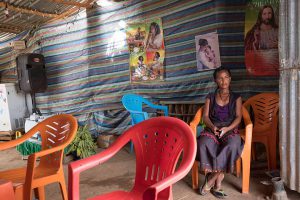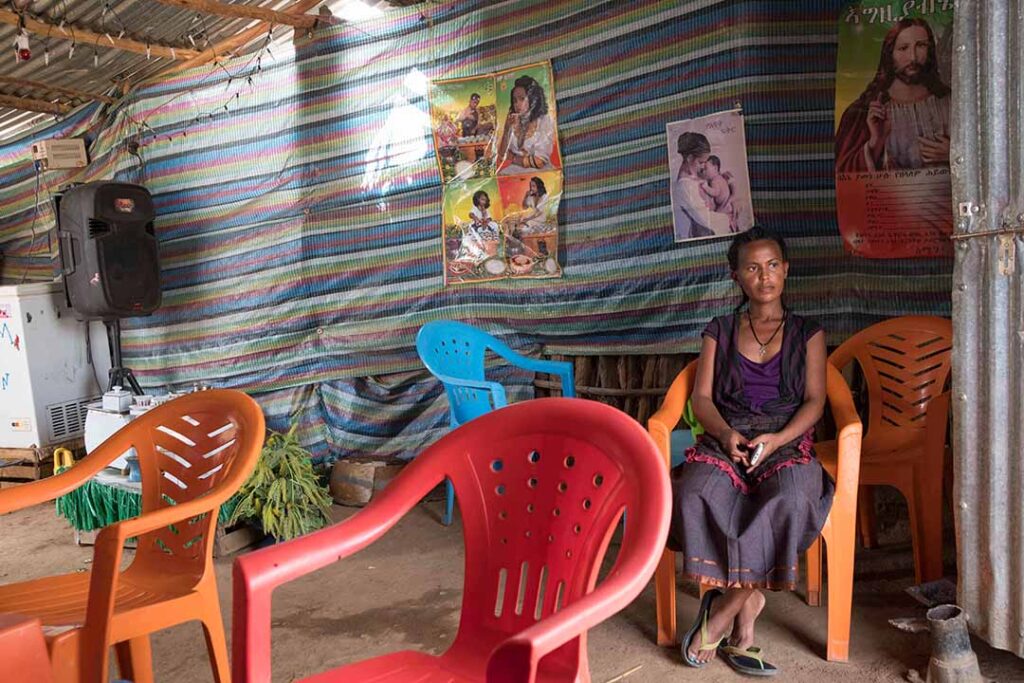Ethiopia and Eritrea: sustainable peace?
The recent thaw in relations between the two countries is embodied in the fears and hopes of people living in a disputed border town

At first glance, Badme – a dusty border town between Ethiopia and its northern neighbour, Eritrea, with an estimated population of several thousand people – looks an unlikely place for a border clash. Yet the savannah grasslands surrounding the town saw pitched battles that started in May 1998, involving tanks, heavy artillery, war planes, landmines and small arms, that left thousands from both sides dead and thousands of others maimed or wounded. A memorial for dead Ethiopian soldiers at the entrance to the town symbolises the emotional baggage that remains 18 years after the war ended. The Tigray People’s Liberation Front (TPLF) was the dominant member of Ethiopia’s ruling coalition with the Eritrean Liberation Front (EPLF). The two were allies from the 1970s, when they sought to overthrow the military government of Mengistu Haile Mariam, and cooperated until the defeat of Mengistu’s forces in May 1991.
The new TPLF-dominated coalition government, the Ethiopian People’s Revolutionary Democratic Front (EPRDF), was the first to recognise Eritrean independence in April 1993, after a referendum saw an overwhelming number of Eritreans voting to secede from Ethiopia. The TPLF said it fought for the creation of a federal Ethiopia, and did not seek independence for Ethiopia’s northern territory, Tigray. The confrontation between the two countries that started in Badme was fought along a common border some 1,100 km long and went on for two years at a cost of an estimated 70,000 lives on both sides. The conflict ended formally in December 2000 after the two sides signed a peace agreement in Algiers – but 18 years of tense armed standoff followed, right up until July 2018.
Currently held by Ethiopia, but claimed by Eritrea, many on both sides will have wondered what the town’s fate would be after Ethiopia’s new prime minister, Abiy Ahmed, and longtime Eritrean President Isaias Afwerki signed a peace agreement in July 2018. A boundary commission established after the December 2000 Algiers peace agreement ruled that Badme, which sits on the edge of a triangular strip of Ethiopian land surrounded by Eritrea, belongs to Eritrea, and the country had been calling for Badme’s unconditional handover for 16 years. In June 2018, Eritrea changed its uncompromising position on negotiations after the senior party in Ethiopia’s ruling coalition EPRDF declared its unconditional commitment to the Algiers peace agreement. This was seen by many as an implicit admission that Badme belonged to Eritrea. One year later, Badme residents are suspended between the hopes of the peace agreement and fears about the town’s uncertain status.
Meanwhile, though, the town and its significance are rarely discussed in either Eritrea’s capital, Asmara, or Addis Ababa, the capital of Ethiopia. The citizens of the town used to live “under the protection of the Ethiopian army”, with the ongoing possibility of conflict with Eritrea looming over their lives, says Beyench Belay, 60, a long-time Badme resident and mother of one who lives by selling basic commodities from her small shop. However, tension has eased somewhat since the July 2018 peace agreement, she adds. Nevertheless, Belay believes that Badme should remain in Ethiopia if there is to be a sustainable peace between the two countries. “We haven’t been told to vacate the town, although I have heard rumours on its ‘planned handover’ to Eritrea,” she told Africa in Fact. She added that, in her view, the transfer of Badme to Eritrea “would not be done easily”, given the lives that had been lost.
Belay’s view, however, is not shared by 18-year-old Martha Hadush, who has lived in Badme all her life. Martha (Ethiopians don’t have family names, but use first names and the father’s name) lives with her family in Badme and makes ends meet by selling a traditional alcoholic drink known as tella. She would “sacrifice” the town if it meant a better future, she says. “I look eagerly to see the day I can visit Eritrea,” she told Africa in Fact. “I wish for there to be sustainable peace and love, and if that means giving up on Badme, I’m ready to do it.” But she added that she didn’t intend to stay in Badme anyway; she plans to move elsewhere in Ethiopia in the hope of getting employment in the public sector or in another business. Such different views go back to the start of the Ethiopia-Eritrea war, according to Martin Plaut, a former BBC Africa editor and observer of Eritrean politics since the 1980s, when Eritrea was still part of Ethiopia.
Differences between the two former liberation groups, the TPLF and the EPLF, are at the heart of current disagreements, he told Africa in Fact. “The immediate causes [of the war] were many, including petty disputes between farmers along the border and Ethiopia’s belief that the [region’s] coffee crop was being sold off at a profit by Eritreans,” he said. “The EPLF’s attitude towards the TPLF (whom they treated as ‘little brothers’) and theoretical differences over Marxism also laid the seeds of future disagreement.” But the thaw in Ethiopian-Eritrean relations has slowed, with four border points that had re-opened since September 2018 closed on the Eritrean side without explanation. The peace deal needs to go beyond the personal chemistry between the countries’ two leaders, Plaut urges, and be institutionalised to avoid any repeat of the misunderstandings that led to the Ethiopia- Eritrea war.
Landlocked Ethiopia says that it wants a closer economic union, so that it can direct some of its foreign trade through Eritrean ports. This has been met by a stony silence from Eritrea, fuelling speculation that the peace has stalled after 18 years of “no war, no peace”. Eritrea has a much smaller population than Ethiopia and a stagnating economy and, according to a BBC report, some townsfolk fear being overwhelmed by Ethiopian goods. It is also thought that tens of thousands of Eritreans may have taken advantage of the temporary border opening to ask for asylum in Ethiopia. Some of these migrants may be using Ethiopia as a transit point to travel to other African countries in search of freedom and better economic opportunities. Much of the unpredictability of the situation may be due to the Eritrean leader, according to Plaut. “Isaias is notoriously fickle in his opinions, and it suits him when the situation is fluid and complex rather than rules-based. He wants to manipulate and control.
Abiy, meanwhile, has too many issues on his plate to really concentrate on his ties with Eritrea.” Plaut added that the border closures might have been avoided if civil servants had been tasked with reaching agreement on how the formerly disputed territories should be dealt with, and with drawing up proper rules and regulations. In a recent interview disseminated on YouTube, Abiy indicated that he thought that the need to “harmonise trade customs matters and the non-return of Eritrean opposition groups” were reasons for the closures. An Ethiopian government official recently told Africa in Fact, on condition of anonymity, that Ethiopia believes the closures from the Eritrean side are a temporary measure. The country has stationed customs officers at three border checkpoints with Eritrea in anticipation of a resumption of border trade. Plaut says Isaias will probably resist getting Ethiopian-Eritrean ties on a stable footing, but he is optimistic about the prospects of improved relations between the two East African countries.
“It is self-evident that the future requires both nations to cooperate and work on joint projects for their mutual benefit,” he told Africa in Fact. “Little really divides their peoples, who are energetic and dynamic.” Plaut’s optimism is shared by Belay, who has enjoyed a personal benefit from the diplomatic thaw between Ethiopia and Eritrea: she was able to reunite with her sister after 30 years. “She came across the border from Tekemobia, in Eritrea, to meet me,” Belay said. Other Badme residents say that people from the two countries are moving relatively freely across the border to trade in gold, livestock and basic commodities, despite the border points being formally closed from the Eritrean side. This is probably an indication that the rigid separation between the two countries introduced after the 1998-2018 war will not return.



